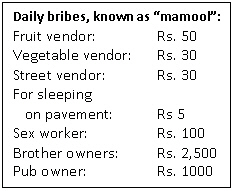By Kollengode S Venkataraman
They are not the officials who take the bribes offered. They are the officials who ask for bribe as a precondition. If you’re confused and wonder what the difference is, you do not know how India works.
A recent news story in The Hindu on Bangalore, India’s high-tech city, throws light onto the murky business of bribery. In Bangalore’s bazaars, when police constables come for their daily evening patrols (beats), the street vendors, on their own, without the constable even making eye contact, stuff the police with cash. A policeman was candid: “I get Rs. 30,000 a month without asking anybody for bribe.”
A friend asked a police officer in Bangalore, “Who is an honest policeman?” The officer replied: “One who doesn’t go out of his way to extort money.” In Bangalore, the normal bribe rate is even formalized so there is no misunderstanding. See the box below.
If this is the situation in Bangalore, you can imagine how it will be in Chennai, Hyderabad, Delhi, Mumbai, Kolkata and other cities. This system is the same in commercial tax departments, customs clearing houses, public works departments, motor vehicles departments, and even government hospitals.
Business people big and small factor these mamools as the cost of doing business, similar to franchise and licensing fees and royalty, and transfer the cost of the bribes to their customers. India is a shining example of a nation whose ordinary consumers subsidize the lifestyles of the corrupt officials and businesses.
Corruption in India is so endemic that nobody complains to the authorities even though they may whine about it in private. Besides, India has perfected corruption to such that everybody is simultaneously both a victim and a beneficiary of corruption. When you benefit in one situation, how can you complain when you are the victim in another?
Another reason why nobody goes through the criminal justice system is simply because the criminal justice system “local policemen and judges in lower courts” itself is corrupt. That brings to mind a Ramayana story I’ve read decades ago in a Tamil magazine.
Rama was standing on a riverbank holding Kodandam, his bow, on his side with one end of the bow sticking into the sand. Rama, hearing a feeble moan from the ground below, looked down. The tip of his bow was resting on the back of a frog, pinning the wretched creature to the ground. Rama, known for his compassion, was horrified. He asked the frog, “Why didn’t you call me for help?”
The frog replied, ““”Rama, if others hurt me, I can call you for help. When you yourself are the cause for my pain, who shall I call?”
Indians feel like the frog in the Ramayana story. Besides, they know only too well the criminal justice system is not anything like the compassionate Rama. So, they rarely use their court system seeking justice, whether it is for petty theft, violence against women, or even big-time land-grab cases. According to a recent report of the Indian Supreme Court, 28 million cases are pending in India’s lower courts, or 28 cases for every 1000 people. They don’t want to be harassed also by the police and the lawyers. Enough already!
They wisely try to settle their disputes using bribes or highly effective extra-judicial resources. These extra-judicial sources become the criminal underworld. Working closely with the political class, they move up the social chain, sometimes even becoming legitimate elected officials.
But then, every society, including the US, has its own version of this model of social upward mobility.
— April 2013

